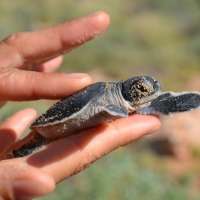Scientists measure impact of artificial light on sea turtles

Research carried out by The University of Western Australia, the Australian Institute of Marine Science and the Department of Parks and Wildlife has found new evidence that there is an impact from artificial light on the survival of wild sea turtle hatchlings.
Using the latest micro-technology, the scientists tracked the movements of green turtle hatchlings (Chelonia mydas) for the first time, as they moved through the water near the shore of the Ningaloo Reef in Western Australia.
The research found that 90 per cent of the tracked hatchlings swam towards the artificial light thinking it was the moon and becoming disorientated in their journey offshore.
UWA Professor of Coastal Oceanography Charitha Pattiaratchi said the scientists measured oceanographic parameters during the experiments that enabled them to isolate the effects of the artificial light on the hatchlings by looking at the effects of ocean currents.
"It is widely known that artificial lighting near turtle nesting beaches attracts turtle hatchlings as they emerge from nests and can cause them to have trouble finding the sea," Professor Pattiaratchi said.
"But understanding what happens once they reach the sea and how lights on water from sources such as boats, ports and wharves affect them has been unknown up until now because we lacked a simple means to track them."
The study provides key behavioural insights into the extent of the impact to hatchling survival caused by changes in light conditions.
The movements of turtle hatchlings were tracked with miniature tracking devices in waters near the shore under conditions of natural and artificial light and then assessed for the effect of artificial light on swimming direction and behaviour. The hatchling movements were also compared with measured ocean current patterns.
The results have implications for existing and future industrial developments near hatching beaches of marine turtles.
More information: Michele Thums et al. Artificial light on water attracts turtle hatchlings during their near shore transit, Royal Society Open Science (2016). DOI: 10.1098/rsos.160142
Journal information: Royal Society Open Science
Provided by University of Western Australia
















